When you are running a small business there is a myriad of challenges you need to face daily. One of the most pressing issues is how to stand out in a competitive marketplace and convince potential customers that you are as trustworthy and reliable as the big names in the industry.
Nowadays, the most efficient way to make this happen is content marketing.
However, small businesses are more often than not reluctant to undertake risky endeavors as their budgets are limited and every unsuccessful attempt may cause them losses that are hard to recover from.
So how to know whether content marketing is the right choice for small and medium companies?
In this article, we’ll provide a coherent guide in which we’ll answer all your questions, outline a practical content marketing strategy, and share pro tips to get you started.
Read on and take notes!
What Is Content Marketing?
Content marketing is a digital marketing approach in which companies create different types of online content to attract and engage their audience. These can include articles, blogs, videos, social media posts, podcasts, infographics, and other non-advertising formats.
Content marketing is part of the inbound marketing strategy, and, as such, allows the customer to discover and contact the brand themselves, as opposed to outbound techniques where the company reaches out to its audience instead.
In their content, small businesses offer valuable insights, guides, and relevant information about their offerings, freely accessible to the consumer. These resources aim to address customer challenges, provide education on topics of interest, and simplify their lives.
For small businesses, the objective is to gain visibility, earn consumer trust, establish a relationship, and present their offerings as a viable choice. However, it’s crucial to refrain from overt product promotion, especially in the early stages of the funnel. Doing otherwise may undermine the business’s credibility and lead the consumer to consider everything else they hear to be hidden advertising.
Benefits of Content Marketing for Small Businesses
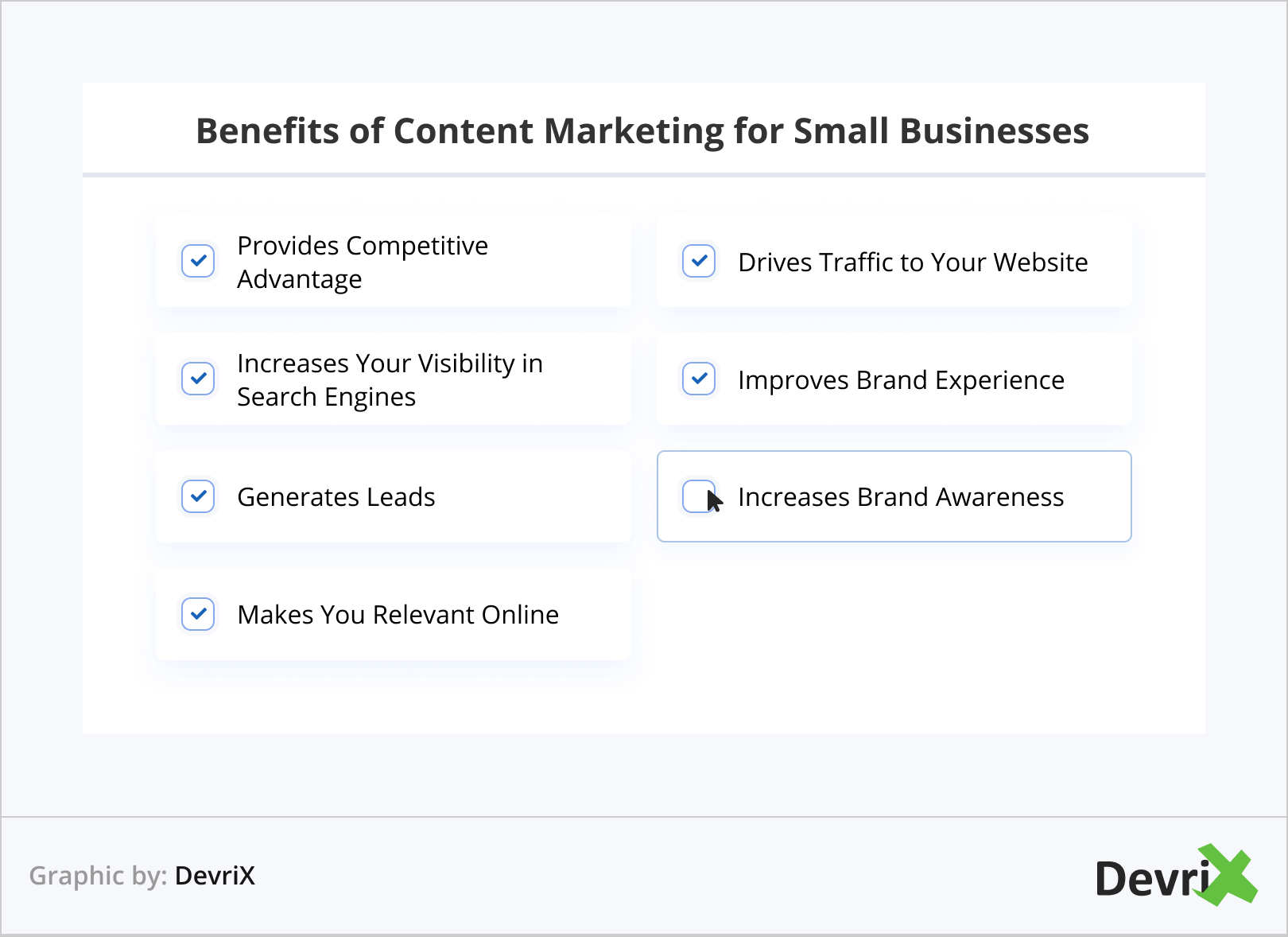
The greatest benefit of content marketing for small businesses is that it can put them on par with established companies with far larger budgets than theirs. It allows them to build a brand online, reach new markets, expand their operations, and grow.
Furthermore, once you set your strategy in motion and start publishing, your content can provide lasting results, with minimal additional effort.
While all this may not be as easy for small businesses as it is for their more powerful counterparts, with hard work and dedication, it’s possible.
- Drives Traffic to Your Website. Distributing your content via different communication channels is the best way to drive organic traffic to your website.
- Increases Your Visibility in Search Engines. Optimizing your pages for search engines, allows you to rank for more relevant keywords, and makes your brand more visible in organic search results.
- Generates Leads. Content marketing is one of the most powerful lead generation tools of the inbound strategy.
- Improves Brand Experience. Delivers additional value to customers at different stages of the journey.
- Increases Brand Awareness. Customers can discover your website through your content and learn about your brand.
- Makes You Relevant Online. Regularly publishing relevant content on different platforms allows you to build a strong digital presence.
Content Marketing Strategy for Small Businesses
Creating a strategy is an important step in your content marketing efforts. It will help you clearly visualize your course of action, delegate the proper budget to the pertaining activities, and organize your work.
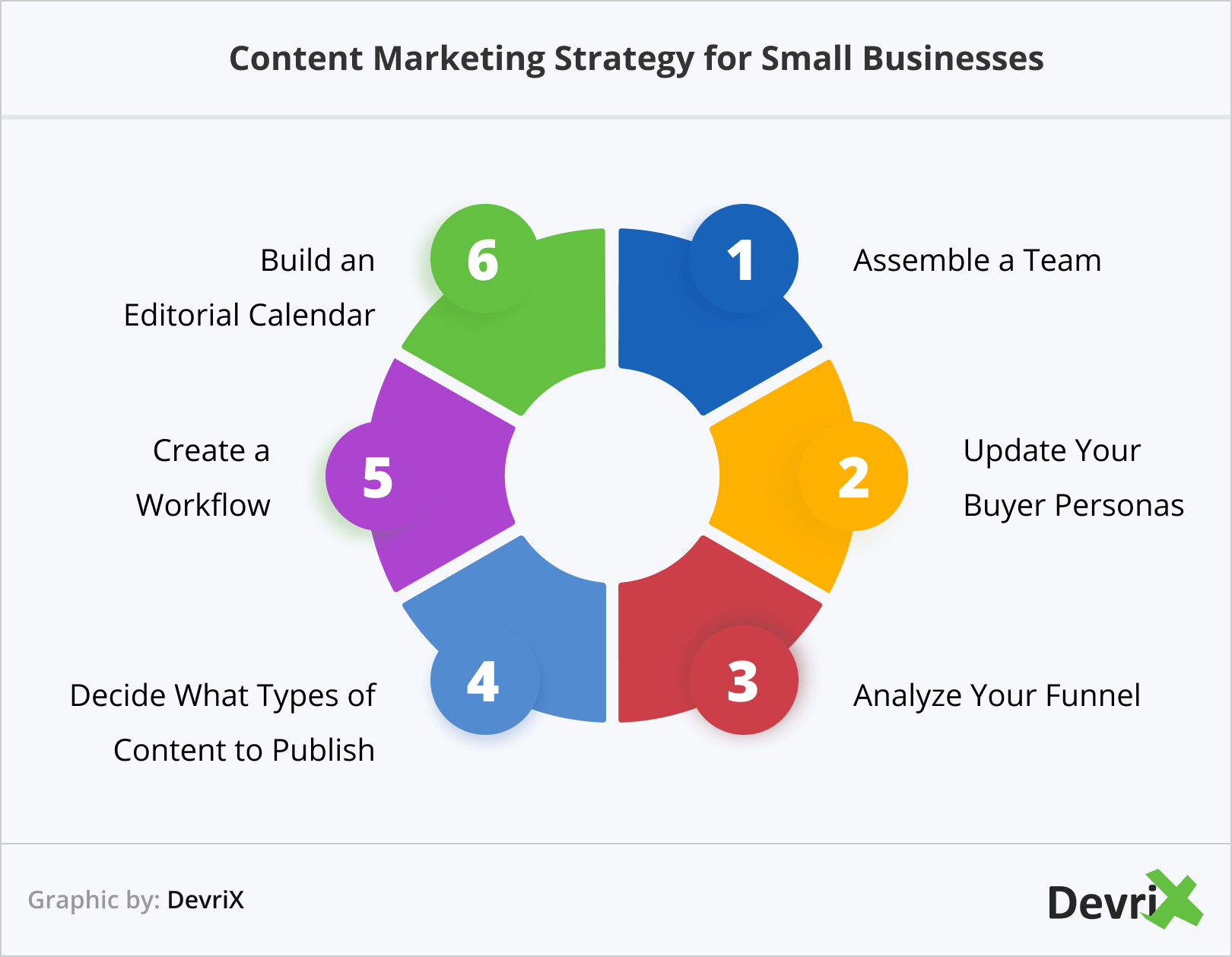
1. Assemble a Team
As a small business, you may not be able to assemble a team of content specialists at first. However, the good thing about content marketing is that you can make it work even with limited resources.
There are a number of roles that the process involves, but these can be distributed between a few team members, and, on occasion, can even be done by a one-man show:
- Content Strategist. Does the planning, decides what content the company needs, who can write it best, and when to publish it.
- Content Manager. Oversees the production process, coordinates tasks, and publishes the content on the relevant channels.
- Writer. Writes, updates, and repurposes content when needed to fit the company’s strategy.
- Editor. Proofreads, edits, and makes sure that there aren’t any inconsistencies.
- Subject Matter Expert. Checks if the information is correct, and provides improvement suggestions.
- Graphic Designer. Designs, implements, and optimizes images.
- SEO Expert. Makes sure that the content is properly optimized and meets the standards and requirements of search engines.
Regardless of how many people you have on your team, to ensure that everything runs smoothly, you need to know who’s responsible for each role and make sure that there are no silos in your strategy implementation.
2. Update Your Buyer Personas

The ultimate goal of content marketing is to attract your target audience, introduce them to your brand, win their trust, and show them that your business is their best choice. To do this, you need to examine your audience thoroughly. This will show you what the customer’s pain points and struggles are and how they can benefit from your knowledge and expertise.
If your buyer personas are not up-to-date, you may end up wasting your time creating content that doesn’t resonate with your audience. As a result, you will attract the wrong leads and will see fewer conversions than expected.
Furthermore, the market’s trends and requirements are constantly changing, so to remain relevant, you need to regularly conduct market research and adjust your personal profiles.
Although this sounds fancy and expensive, fret not, if you ask the right questions, even a simple digital survey distributed on your communication channels can help you learn what you need to know.
3. Analyze Your Funnel
The marketing funnel visualizes the stages of the buyer journey that your customer goes through before they make a purchase.
At the top of the funnel, are the fresh leads – the people who are just learning about your business; in the middle are the people who are considering buying from you; and at the bottom are the ones who are ready to convert.
Each stage of the content marketing funnel calls for different formats. The goal is to provide your customers with the right kind of information, depending on where they are in their journey, and give them a reason to move to the next stage.
Top of the funnel content includes:
- Blog Posts
- Infographics
- Podcast
- Social Media Reels
- Videos
Mid-funnel content can be:
- Case Studies
- Reports
- Ebooks
- Whitepapers
- Templates
- Webinars
- Email Courses, etc.
Bottom funnel content usually focuses on:
- Testimonials
- Customer Success Stories
- Competitive Comparison
- Demos
- Free trials
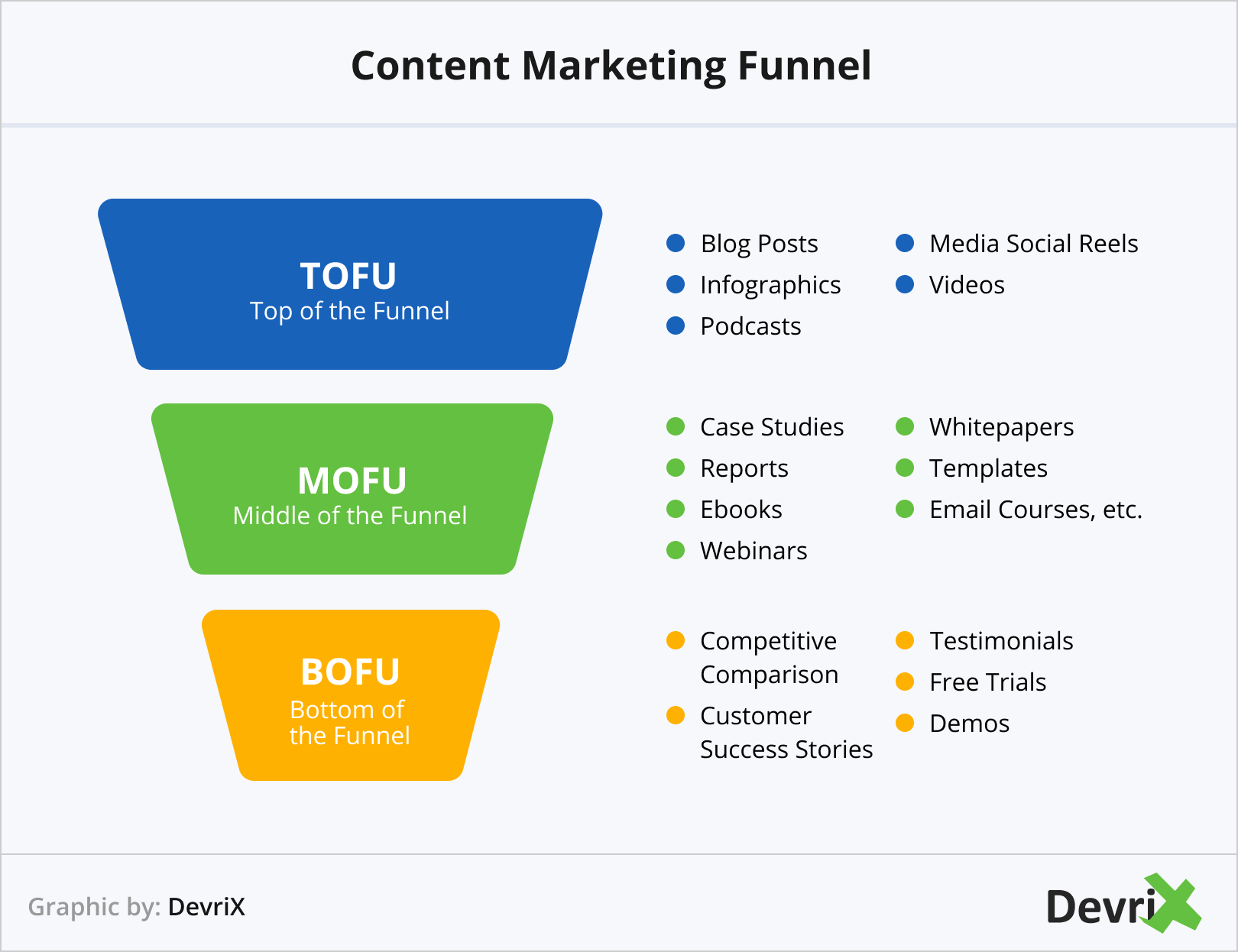
Furthermore, if you decide to go the extra mile, the content marketing funnel may not end with the conversion, but continue to provide value to the customer in the post-purchase stage as well. There, you can offer them information on how to benefit the most from the product, encourage them to share user-generated content, send them surveys, etc.
4. Decide What Types of Content You Will Publish
When you’re initiating your content marketing strategies as a small business with limited resources, it’s best to start by focusing on only one form of content. This will allow you to figure out your style, gain experience, find out what works for you, and readjust your process to optimize it.
Once you’ve become proficient in your chosen content form, you can consider repurposing what you’ve already published into different formats. This way, you can easily test out how successful they are.
For example, many small businesses initiate their journey with a blog. As your content volume grows, leveraging modern technology, it’s easy to convert your articles into podcasts and reach a whole new audience. And when you start creating stand-alone audio content, you can make the transcripts available on your blog.
Next, these can be repurposed into video, social media carousels, infographics, and whatnot.
This way, your channels will support each other and your content will be available in the forms that are convenient to different customers.
However, to decide what formats are best for you, you should first research what your target audience is into. This will allow you to focus your efforts and maximize engagement.
5. Create a Workflow
Creating a content workflow is the best way to optimize and streamline your content creation process. They allow you to clearly define the steps in the production line, making them more manageable.
Everyone in the content team (even if it’s just a handful of people) should be aware of their responsibilities, who precedes and follows them in the pipeline, and everyone’s deadlines. This minimizes the risk of mistakes and delays and reduces blockers.
Furthermore, the fewer people engaged in content production, the larger the consequences are when somebody misses a deadline. If you have a team of 10 writers and one falls behind, the others can compensate. However, if you’re simultaneously the writer, editor, and content manager, any delay jeopardizes your entire operation.
In short, workflows optimize productivity, reduce stress, and make it easier for teams to meet their targets. This makes them vital for small businesses, as they allow the content production process to run smoothly and efficiently.
6 Tips for Developing an Efficient Content Workflow [+Template]
6. Build an Editorial Calendar
Planning and scheduling is the key to successful content marketing. While the workflow organizes the day-to-day tasks involved in content creation, an editorial calendar provides an overview of your publication strategy. This includes what type of content to publish and when, which headlines to fit into the available slots, who is responsible for production, what stage of development the piece is in, etc.
What information to include in the calendar and what format it will be in, depends on your preferences and resources. You can opt for a simple desktop organizer or digital spreadsheet, or go as far as purchasing dedicated software. Whatever your choice is, make sure that the document facilitates collaboration and is clear and easy to understand by everyone involved.
Some businesses prefer to make separate calendars for each type of content they produce – blog, social media, podcast, video, etc. However, it’s a good practice to have one editorial calendar that unites them all. This way, you will be able to better plan your content marketing efforts, track all processes, and maintain consistency in your strategy.
Tips for Successful Content Marketing
Here is a list of practical tips that will help you successfully implement a content marketing strategy in your small business:

- Do SEO from the Beginning. Search engine optimization (SEO) is vital for content marketing success. If your pages are not optimized, people may not be able to find them through organic search. It’s a good rule of thumb to start optimizing your content immediately and keep up with search engine requirements, rather than think of it post-factum when you already have hundreds of pages.Also, remember that SEO is not a one-off event, it’s a continuous process. Although it may be difficult at first, if you make it part of your routine, it will become easier to implement over time.
- Create a Following on Social Media. Social media is a great place to reshare your content and encourage your audience to engage. You can adjust each piece to match what best fits the different platforms, and monitor how people respond to it. By providing them with what they like and want, you increase the likelihood of them
clicking on your links. This way you can boost the traffic to your content, and, as a result, increase your visibility online and grow your audience. - Distribute Your Content via Email. Email is one of the most reliable digital marketing channels and allows you to distribute your content to a larger, targeted audience with minimal effort. To maximize performance, you should align your content marketing funnel with your email funnel.
- Repurpose Content. Repurposing content for different channels is an easy way to populate your calendar with different types of content and reach your audiences in a way that’s convenient for them.
- Update Content Regularly. You should make a schedule for each piece of content to be updated depending on how time-sensitive it is and how quickly the information in it has changed and/or becomes outdated. The point is, that whenever a customer ends up on one of your pages, what they need to find there is relevant and valuable content.
- Be Consistent. Consistency is vital for the success of your content marketing strategy. Regardless of how often you decide to publish content, you should stick to your schedule and never miss a due date. This way your customers will know what to expect and may create a habit of checking out your channels.
- Build a Stockpile. It’s important to build up enough content before you start publishing. This way, you’ll ensure that you are able to maintain consistency and have the flexibility to avoid setbacks without them affecting performance.
- Produce Both Evergreen and Current Content. Current content is a great way to stay relevant and keep your audience updated on industry trends and news. However, evergreen content brings in steady traffic to your website and can be a great source of leads over time. Balancing the two will help you keep your customers interested.
- Build a Top-Quality Website. Online, people judge a brand based on its website. And when it comes to content marketing, most of what you publish will be there. To make a good impression and provide a pleasant user experience, your online property needs to be fast, responsive, mobile-friendly, and pleasant to the eye. This way, when people click on your links and land on your pages they will be able to interact with your content without any problems.
- Don’t Be Shy to Share Your Knowledge. One of the unspoken rules of content marketing is to give away (almost) all of your knowledge for free, provide valuable information, and encourage engagement. While the first part of this may sound counterintuitive, keep in mind that your expertise is what sets you apart, and what attracts paying customers.
Bottom Line
The expansive digital marketplace of 2023/2024 is brimming with small businesses striving to convince their audiences that they are better than the rest. However, consumers nowadays are wary of false promises and fake advertising. To stand out in this crowded space, a business must first earn the trust of its potential customers. That’s where content marketing comes in.
Content marketing is a strategic approach for small businesses to exhibit their industry expertise, validate their experience, and above all, express their dedication to their network.
What sets content marketing as the pinnacle of inbound marketing and makes it so much better than traditional advertising is that, to the customer, it’s free! You help them find solutions, without asking for anything in return. This customer-centric approach has proven to be effective for small businesses growing in the past years.
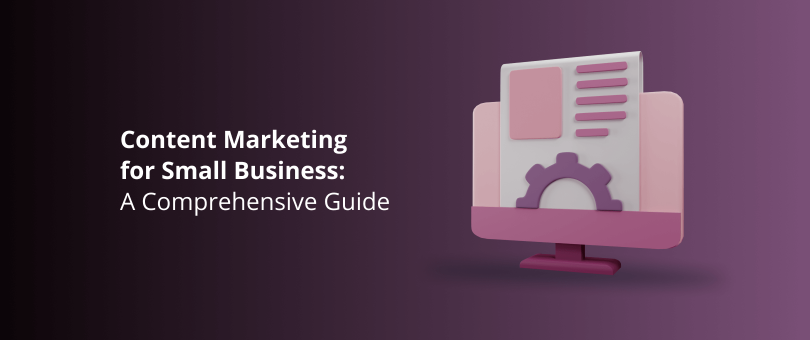

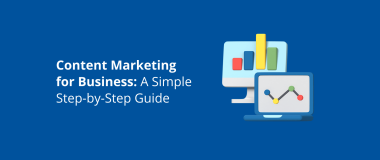

![6 Ways to Strengthen Your B2B Content Marketing Strategy [Part 1]](https://devrix.com/wp-content/uploads/2019/12/6-Ways-to-Strengthen-Your-B2B-Content-Marketing-Strategy-Part-1@2x-380x160.png)